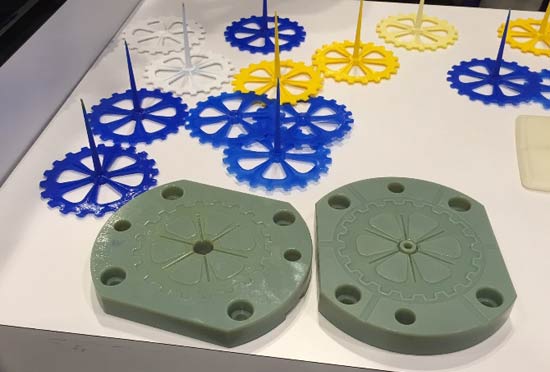Stratasys 3D Printing: Service Bureau Shifts from Metal to 3D Printed Injection Molds - Design to Test Parts Reduced to Just 7 Hours
Stratasys 3D Printed Injection Molds for the Service Bureau – Design to Test Parts Reduced to Just 7 Hours
Accelerated injection molding applications are unlocking new business models for companies like Milacron LLC, a global full-line supplier of injection molding, blow molding and extrusion machines, hot runners, mold technologies, process control systems and fluid technology. The prototyping service provider recently added PolyJet-based 3D printed injection molding to their innovative portfolio, enabling them to make significant strides in reducing development cycles and improving the delivery of customer products to market.
Milacron was approached with a customer project which required the production of low volume gear prototypes. Milcaron’s Mold-Masters hot runner facility oversaw the injection molding process. According to Witold Neter, Technical Development Manager for Mold Masters traditional processes would involve creating an injection mold cavity out of steel or aluminum. This process would often take days, sometimes weeks to produce. The cavity mold would then be installed into the injection molding machine to develop customer prototypes.

This 3D printed injection mold was produced in just a few hours on the PolyJet-based Objet500 Connex3 3D Production System from Stratasys
PolyJet-based 3D printed injection molding is best suited for low run prototyping parts with a high volume of iterations. Milacron was able to produce an injection mold cavity with PolyJet-based Digital ABS materials on the Stratasys Objet500 Connex3 3D Production System within five hours. The injection mold was installed into their molding machine, and a prototype was available within two hours. This process enabled Milacron to output a number of iterations without sacrificing production workflows.
“Every time you want to change the geometry – we change the file, we print it again, and repeat the process until its perfect,” explained Neter. “It cuts the time of our prototyping and delivery time for our customer.”
Time to market is a critical factor for Milacron. Michael Ellis, director of Global Marketing & Communications at Milacron, believes Stratasys PolyJet-based 3D printers provide considerable value to their bottom line. “With 3D printing, we can 3D print the mold cavity and use them for prototyping jobs. That allows our customers to get their prototypes into the market faster, thus approving their products for final release and high volume production,” said Ellis.

 Blog
Blog